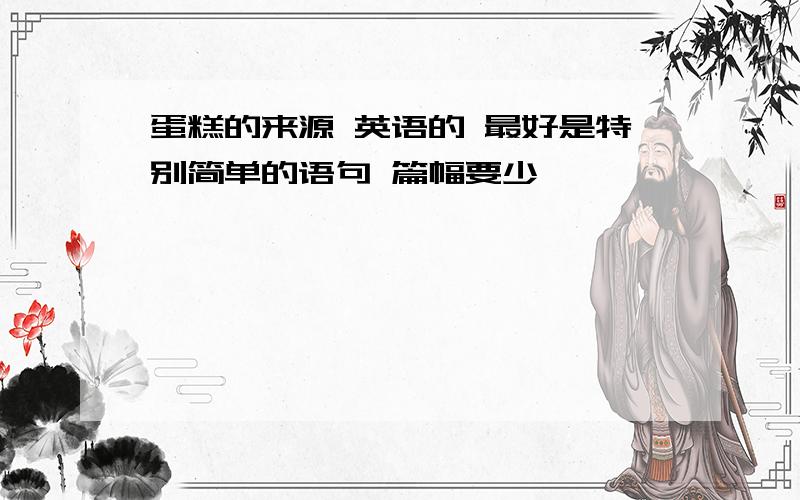蛋糕的来源 英语的 最好是特别简单的语句 篇幅要少
来源:学生作业帮助网 编辑:作业帮 时间:2024/11/15 13:05:18

蛋糕的来源 英语的 最好是特别简单的语句 篇幅要少
蛋糕的来源 英语的 最好是特别简单的语句 篇幅要少
蛋糕的来源 英语的 最好是特别简单的语句 篇幅要少
蛋糕的历史:
Histroy of cake:
Europe and places such as North America where European influence is strong have always been the center of cakes.One might even draw a line more tightly,fourn English-speaking areas.No other language has a word that means exactly the same as the English 'cake.' The continental European gateau and torte often contain higher proportions of butter,eggs and enriching ingredients such as chocolate,and often lean towaars pastry rathern than cake.Central and East European items such as baba and the Easter kulich are likewise different.
The western tradition of cakes applies little in Asia.In some countries western-style cakes have been adopted on a small scale,for example the small sponge cakes called kasutera in Japan.But the 'cakes' which are imporant in Asian are quite different from anything occidental for examples,see mooncakes and rice cakes of the Philippines.
The history of cakes,goes a long way back.Among the remains found in Swiss lake villages were crude cakes make from roughly crushed gains,moistened,compacted and cooked on a hot stone.Such cakes can be regarded as a form of unleavened bread,as the precursor of all modern European baked products.Some modern survivors of these mixtures still go by the name 'cake',for instance oatcakes,although these are now considreed to be more closely related to biscuits by virtue of their flat,thin shape and brittle texture.
Ancient Egypt was the first culture to show evidence of true skill in bakin,making many kinds of bread including some sweetened with hone.The Greeks had a form of cheesecake and the Romans developed early versions of fruitcakes with raisins,nuts and other fruits.These ended up in 14th century Britain.Chaucer mentions immense cakes made for special occasions.One was made with 13 kilograms of flour and contained butter,cream,eggs,spices,currants and honey.
During the 19th century,technology made the cake-baker's life much easier.The chemical raising agent bicarbonate of soda,introduced in the 1840's,followed by baking powder ( a dry mixture of bicarbonate of soda with a mild acid),replaced yeast,providing a greater leavening power with less effort.Another technology breakthrough was more accuate temperature controlled ovens.
In most of NW Europe and North America a well-developed tradition of home baking survives,with a huge repertoire of cake recipes developed from the basic methods.The abililty to bake a good cake was a prized skill among housewives in the early to mid-20th century,when many households could produce a simple robust,filling 'cut and come again' cake,implying abundance and hospitality.
Although the popularity of home baking and the role of cakes in the diet have both changed during the 20th century,cakes remain almost ubiquitous in the western world.They have kept their image as 'treats' and maintain their ceremonial importance at weddings and birthdays.
Europe and places such as North America where European influence is strong have always been the center of cakes. One might even draw a line more tightly, fourn English-speaking areas. No other languag...
全部展开
Europe and places such as North America where European influence is strong have always been the center of cakes. One might even draw a line more tightly, fourn English-speaking areas. No other language has a word that means exactly the same as the English 'cake.' The continental European gateau and torte often contain higher proportions of butter, eggs and enriching ingredients such as chocolate, and often lean towaars pastry rathern than cake. Central and East European items such as baba and the Easter kulich are likewise different.
The western tradition of cakes applies little in Asia. In some countries western-style cakes have been adopted on a small scale, for example the small sponge cakes called kasutera in Japan. But the 'cakes' which are imporant in Asian are quite different from anything occidental for examples, see mooncakes and rice cakes of the Philippines.
The history of cakes, goes a long way back. Among the remains found in Swiss lake villages were crude cakes make from roughly crushed gains, moistened, compacted and cooked on a hot stone. Such cakes can be regarded as a form of unleavened bread, as the precursor of all modern European baked products. Some modern survivors of these mixtures still go by the name 'cake', for instance oatcakes, although these are now considreed to be more closely related to biscuits by virtue of their flat, thin shape and brittle texture.
Ancient Egypt was the first culture to show evidence of true skill in bakin, making many kinds of bread including some sweetened with hone. The Greeks had a form of cheesecake and the Romans developed early versions of fruitcakes with raisins, nuts and other fruits. These ended up in 14th century Britain. Chaucer mentions immense cakes made for special occasions. One was made with 13 kilograms of flour and contained butter, cream, eggs, spices, currants and honey.
During the 19th century, technology made the cake-baker's life much easier. The chemical raising agent bicarbonate of soda, introduced in the 1840's, followed by baking powder ( a dry mixture of bicarbonate of soda with a mild acid), replaced yeast, providing a greater leavening power with less effort. Another technology breakthrough was more accuate temperature controlled ovens.
In most of NW Europe and North America a well-developed tradition of home baking survives, with a huge repertoire of cake recipes developed from the basic methods. The abililty to bake a good cake was a prized skill among housewives in the early to mid-20th century, when many households could produce a simple robust, filling 'cut and come again' cake, implying abundance and hospitality.
Although the popularity of home baking and the role of cakes in the diet have both changed during the 20th century, cakes remain almost ubiquitous in the western world. They have kept their image as 'treats' and maintain their ceremonial importance at weddings and birthdays
收起
楼上的回答是不是太长了,你可以在杂志上看看,这样的文章很多……